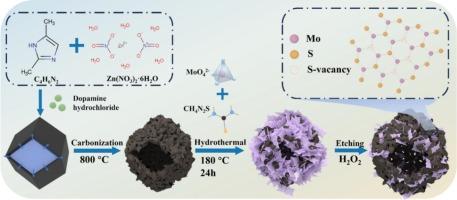Dual regulation of nanostructures and S-vacancy enabling ultra-high sodium storage performance for MoS2/carbon nanocage composites
IF 5.1
3区 材料科学
Q2 MATERIALS SCIENCE, COATINGS & FILMS
引用次数: 0
Abstract
The combination of carbon nanocages and MoS2 can effectively enhance the rate performance of anode materials. However, optimizing the design of composite structures to achieve a balance between high capacity and cycling stability still remains highly challenging. This work demonstrates the successful construction of vertical MoS2 nanosheet arrays on carbon nanocages (MoS2-x/CNC) with strategic S-vacancy engineering. The optimized anode (MoS2-x/CNC3–1) delivers exceptional sodium storage capabilities for half-cell (225 mAh g−1 over 3000 cycles at 10 A g−1) and full-cell (capacity retention of 87 % after 100 cycles). The superior performance originates from a synergistic nanoarchitecture integrating three critical features of enhanced active sites, optimized ion diffusion channels and efficient charge carrier mobility.

纳米结构和s空位的双重调控使MoS2/碳纳米复合材料具有超高的钠存储性能
碳纳米笼与二硫化钼的结合可以有效提高负极材料的倍率性能。然而,优化设计复合材料结构,以实现高容量和循环稳定性之间的平衡仍然是极具挑战性的。这项工作证明了利用战略s空位工程在碳纳米笼(MoS2-x/CNC)上成功构建了垂直MoS2纳米片阵列。优化的阳极(MoS2-x/ CNC3-1)为半电池(在10 A g - 1下超过3000次循环225 mAh g - 1)和全电池(100次循环后容量保持87%)提供了卓越的钠存储能力。优异的性能源于协同纳米结构,集成了增强的活性位点、优化的离子扩散通道和高效的载流子迁移率这三个关键特征。
本文章由计算机程序翻译,如有差异,请以英文原文为准。
求助全文
约1分钟内获得全文
求助全文
来源期刊

Diamond and Related Materials
工程技术-材料科学:综合
CiteScore
6.00
自引率
14.60%
发文量
702
审稿时长
2.1 months
期刊介绍:
DRM is a leading international journal that publishes new fundamental and applied research on all forms of diamond, the integration of diamond with other advanced materials and development of technologies exploiting diamond. The synthesis, characterization and processing of single crystal diamond, polycrystalline films, nanodiamond powders and heterostructures with other advanced materials are encouraged topics for technical and review articles. In addition to diamond, the journal publishes manuscripts on the synthesis, characterization and application of other related materials including diamond-like carbons, carbon nanotubes, graphene, and boron and carbon nitrides. Articles are sought on the chemical functionalization of diamond and related materials as well as their use in electrochemistry, energy storage and conversion, chemical and biological sensing, imaging, thermal management, photonic and quantum applications, electron emission and electronic devices.
The International Conference on Diamond and Carbon Materials has evolved into the largest and most well attended forum in the field of diamond, providing a forum to showcase the latest results in the science and technology of diamond and other carbon materials such as carbon nanotubes, graphene, and diamond-like carbon. Run annually in association with Diamond and Related Materials the conference provides junior and established researchers the opportunity to exchange the latest results ranging from fundamental physical and chemical concepts to applied research focusing on the next generation carbon-based devices.
 求助内容:
求助内容: 应助结果提醒方式:
应助结果提醒方式:


